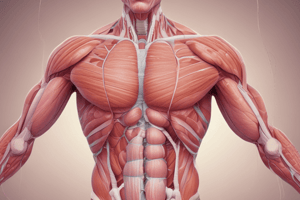Podcast
Questions and Answers
What is one characteristic that smooth and cardiac muscle share?
What is one characteristic that smooth and cardiac muscle share?
- They have striations.
- They are both involuntary. (correct)
- They can be consciously controlled.
- They are both voluntary.
Which fascia surrounds the entire muscle?
Which fascia surrounds the entire muscle?
- Fascia profunda
- Perimysium
- Endomysium
- Epimysium (correct)
Where is calcium stored in the muscle?
Where is calcium stored in the muscle?
- Sarcoplasmic reticulum (correct)
- Golgi apparatus
- Cytoplasm
- Mitochondria
What happens during the power stroke in muscle contraction?
What happens during the power stroke in muscle contraction?
Which energy source offers the longest duration of energy for muscle activity?
Which energy source offers the longest duration of energy for muscle activity?
Which muscle is identified by its ring shape and location around the mouth?
Which muscle is identified by its ring shape and location around the mouth?
What is the function of the insertion point of a muscle?
What is the function of the insertion point of a muscle?
Which branch of the peripheral nervous system is responsible for transmitting signals away from the central nervous system?
Which branch of the peripheral nervous system is responsible for transmitting signals away from the central nervous system?
What type of channel in the cellular phospholipid bilayer responds to chemical signals?
What type of channel in the cellular phospholipid bilayer responds to chemical signals?
What part of the muscle is always stationary during contraction?
What part of the muscle is always stationary during contraction?
Flashcards
Involuntary Muscle
Involuntary Muscle
Muscle that contracts without conscious control.
Extensibility
Extensibility
The ability of a muscle to stretch.
Elasticity
Elasticity
The ability to return to the original shape after being stretched.
Perimysium
Perimysium
Signup and view all the flashcards
Epimysium
Epimysium
Signup and view all the flashcards
Sarcomere
Sarcomere
Signup and view all the flashcards
Sarcoplasmic Reticulum
Sarcoplasmic Reticulum
Signup and view all the flashcards
Acetylcholine
Acetylcholine
Signup and view all the flashcards
Power Stroke (muscle)
Power Stroke (muscle)
Signup and view all the flashcards
Aerobic Respiration
Aerobic Respiration
Signup and view all the flashcards
Anaerobic Respiration
Anaerobic Respiration
Signup and view all the flashcards
Energy Source (least to greatest)
Energy Source (least to greatest)
Signup and view all the flashcards
Creatine Phosphate Energy
Creatine Phosphate Energy
Signup and view all the flashcards
Muscle Contractions
Muscle Contractions
Signup and view all the flashcards
Ring Muscles
Ring Muscles
Signup and view all the flashcards
Diamond-shaped Muscle
Diamond-shaped Muscle
Signup and view all the flashcards
Muscle Origin
Muscle Origin
Signup and view all the flashcards
Muscle Insertion
Muscle Insertion
Signup and view all the flashcards
Efferent Nervous System
Efferent Nervous System
Signup and view all the flashcards
Afferent Nervous System
Afferent Nervous System
Signup and view all the flashcards
Cellular Membrane Channels
Cellular Membrane Channels
Signup and view all the flashcards
Central Nervous System
Central Nervous System
Signup and view all the flashcards
Study Notes
Muscle Characteristics and Function
- Smooth and cardiac muscle are both involuntary.
- Extensibility is the ability of a muscle to be stretched.
- Elasticity is the ability of a muscle to be stretched and return to its original position.
- Perimysium wraps around muscle fascicles.
- Epimysium wraps around the entire muscle.
- A sarcomere is the segment from Z-disc to Z-disc.
- Calcium is stored in the sarcoplasmic reticulum.
- Acetylcholine is the neurotransmitter released at the neuromuscular junction (where nerve and muscle meet).
- The power stroke occurs when actin slides towards the M-line, interacting with myosin.
- Oxygen offers the longest-duration energy source.
- Aerobic respiration requires oxygen; anaerobic respiration does not.
- Energy sources from least to greatest duration: Creatine phosphate, then anaerobic respiration, then aerobic respiration.
Studying That Suits You
Use AI to generate personalized quizzes and flashcards to suit your learning preferences.




